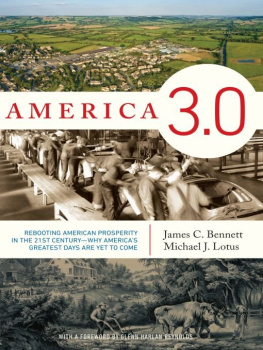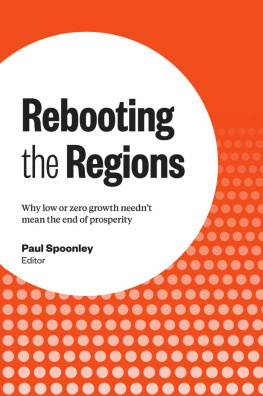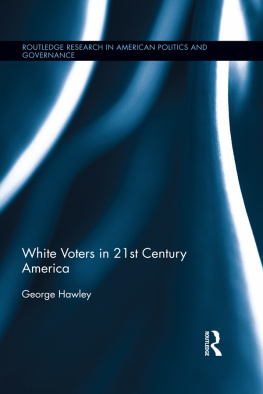Foreword
America Reinvents Itself, Again
Back in the 1980s, everyone was scared of Japan, the fearsome economic competitor that was going to eat Americas economic lunch. Hundreds (thousands?) of books were published on the theme of Americas inevitable decline at the hands of Japanese mercantile wiles. But there was also one book, Joel Kotkins The Third Century: Americas Resurgence in the Asian Era, that took a different position. America, according to Kotkin, had an underappreciated advantage: Its ability to reinvent itself when presented with new challenges. (The Japanese word used by Kotkin and his coauthor, Yoriko Kishimoto, to describe this condition is sokojikara.)
Now were undergoing another round of fashionable doomsaying, though now China is the big foreign threat thats invoked. On the domestic front, worries revolve around excessive debt, dysfunctional educational systems, and, more generally, what Walter Russell Mead calls the failures of the Blue Model of centralized big-government, big-business entities shored up by high taxes and heavy regulation.
Bennett and Lotus call the Blue Model America 2.0. Built up from the early days of the past century, and hitting its peak in the postwar, post-New Deal 1950s, America 2.0 was based on centralization, technocratic/ bureaucratic oversight, and economies of scale. For those still recovering from the stress of the Depression and World War II (once, talking about the 1950s emphasis on comfy domesticity, my grandmother said, You have to understand we were all just so tired by then.) this centralized model also promised stability and safety. You didnt have to be afraid. There were Top Men on the job, and there were Big Institutions ranging from the FHA to Social Security to serve as shock absorbers against the vicissitudes of the greater world.
It worked for awhile. But in time, the Top Men in charge looked more like the bureaucratic wasteland referenced at the end of Raiders of the Lost Ark, while the Big Institutions became not only too big to fail, but also too big and too hidebound to succeed, or to deliver on the promises made on their behalf by politicians. Not only are they no longer the path to the future, their failures are such that we must address them if we are even to have a future.
My favorite reference for the current decade is Steins Law, coined by the late economist Herbert Stein: Something that cant go on forever, wont. The America 2.0 approach, which delivered stability and prosperity to many for decades, is now more problem than solution, as banks fail, bureaucrats flounder, and the economy fails to deliver the jobs or the tax revenues needed to keep the whole enterprise going. Something that cant go on forever, wont.
The old America 2.0/Blue Model is certainly failing, and there is plenty of reason to believe that the transition to something different will have plenty of bumps along the way. But as Bennett and Lotus note here, the problems of the Blue Model are all solvable and, in what they call America 3.0, they will be solved.
Ill add just one further observation. The changes that Bennett and Lotus describe are important, but they are never total. The Jeffersonian individualism that was embodied in America 1.0 never really went away: It exists even now as a layer in our society, one that was overlaid by the America 2.0 structure but that still wields considerable power, both in national mythology and as the constant entrepreneurial breakthroughs coming out of Americas garages demonstrate in reality as well.
Likewise, the replacement of America 2.0 with America 3.0 wont mean that all the bureaucrats will suddenly be begging in the streets, however much some Americans might wish for such an outcome. There will still be big institutions doing things that only big institutions can do. But they wont be as big, or as pervasive, or as important as they used to be.
Something that cant go on forever, wont. Because even a casual look around the American scene reveals a lot of things that cant go on forever ranging from Social Security schemes premised on rising, not falling population; to tuition at colleges and universities that grows faster than family incomes; to government deficits that increase faster than the tax base is likely to; to a criminal justice system that has produced so many criminal laws that even judges and prosecutors cant understand them all its obvious that were in for change in all sorts of areas. Bennett and Lotuss America 3.0 provides an excellent and hopeful look at whats likely to come next.
GLENN HARLAN REYNOLDS
Knoxville, Tennessee
March, 2013
Introduction Hope and Continuity
REGARDING HOPE
We are optimistic about the long-term prospects for American freedom and prosperity. You should be, too.
We believe that positive change is coming, based on the historical record, and on developments underway today. We do not hold to the doom and gloom purveyed in much conservative and even libertarian thinking. Yes, there were good things in the past. Yes, liberty is under attack. And, yes, the current situation is dire. But, no, we are not on an inevitable road to tyranny and poverty. Predictions of the end of America are deeply mistaken.
The current politico-economic regime is falling apart. Yet the underlying strengths we enjoy are also apparent, if you look for them. The short and medium terms, maybe a decade, maybe more, are likely to be difficult. This book explains why we are confident about the future. It also offers some proposals to help get us to a better, freer, more productive life, at least for our children and grandchildren.
REGARDING CONTINUITY AND CHANGE
To understand Americas past, and more importantly its present and future, we need to impose some organizing principle on a very large mass of information and create a simplified model. In so doing we inevitably sacrifice details to try to capture the big picture. We are necessarily imposing an almost brutal oversimplification on a very complex history. But we trust our readers will indulge us, and look at the big picture we are sketching.
We have adopted the current parlance of software development, to describe by analogy the three phases of American life, as America 1.0, 2.0, and 3.0. This terminology should not be taken literally. It is merely a metaphorical shorthand.
America 1.0 was the combination of Americas English cultural and institutional roots with American frontier conditions. These English roots go very deep, back to the settlement of England by Germanic tribes, who displaced the Romans, starting roughly fifteen centuries ago.
Note that the use of the word Germanic for these barbarian tribesmen is the accepted scholarly term. It should not be confused with the German-speaking peoples of Europe. They went down a different cultural path from the English-speaking peoples. Nor should the word Germanic be confused with any modern German political regime.











